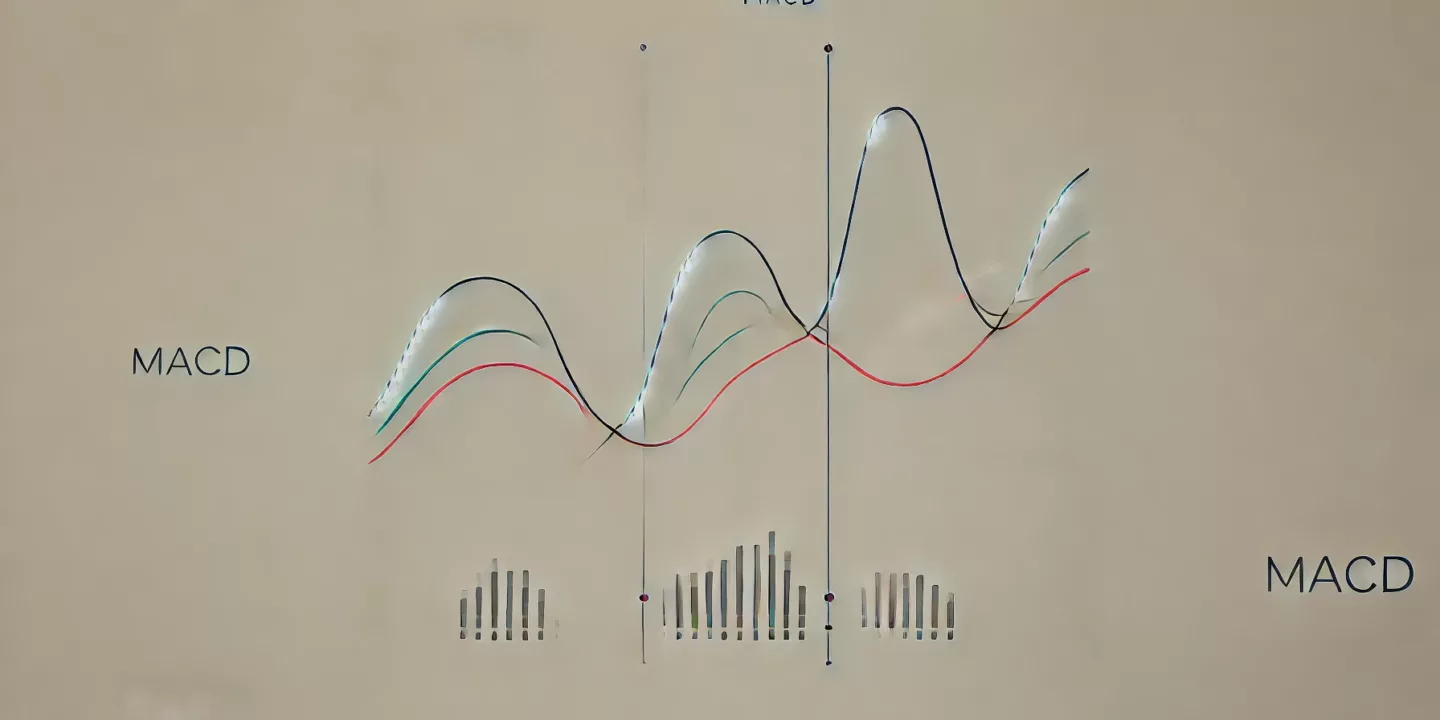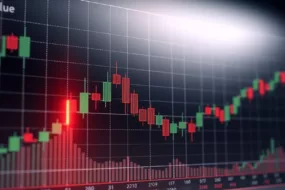
Cryptocurrency trading can be overwhelming for new traders due to its quick price changes and market volatility. To be a successful trader, the cryptocurrency market requires a thought-out and sophisticated strategy. Tools like moving averages can help simplify the process and provide clear insights into market trends. In this article, we will learn about moving averages (macd) in crypto, how they work, and how you can use them to make more informed trading decisions.
What is a Moving Average?
A moving average is a tool that helps traders by smoothing out the price data of a cryptocurrency over a certain period. This tool makes it easier to see the overall direction or trend of the market. Imagine the moving average as a line plotted on a chart that shows the average price over a specific time frame, reducing the impact of short-term fluctuations.
Why Use Moving Averages?
Moving averages are popular among traders because they can identify trends, reduce noise, and generate trading signals. They help you identify trends by seeing if the market is generally moving up, down, or sideways. Reducing noise using moving averages is crucial as cryptocurrency prices can be volatile, going up and down rapidly. Moving averages provide a macro view of the price action, making it easier to spot the trend.
They can also help generate trading signals by indicating an opportune time to buy or sell when the price of a cryptocurrency crosses above or below a moving average. Therefore, with moving averages, you can make more informed trading decisions by looking at the bigger picture and not getting distracted by short-term price movements.
How to Use Moving Averages (MACD) in Crypto Trading
Here is a step-by-step process to use moving averages in your crypto trading strategy:
Step 1: Choose Your Time Frame
Decide on the time frame for your moving average. The period can vary from 10 to 200 days. Short periods react quickly to price changes, while long periods show long-term trends.
Step 2: Analyze the Trend
If the price is consistently above the moving average, it is a sign that the market is in an uptrend. An uptrend shows it might be a time to consider buying. On the contrary, if the price is consistently below the moving average, it is a sign that the market is in a downtrend. A downtrend indicates it might be a time to consider selling or avoiding new purchases.
Step 3: Look for Crossovers
Crossovers are trading signals. There are two crossovers: the Golden Cross and the Death Cross. The golden cross occurs when a short-term moving average crosses above a long-term moving average. It is often seen as a bullish signal, suggesting it is time to buy. A death cross occurs when a short-term moving average crosses below a long-term moving average. It is often seen as a bearish signal, suggesting it might be a good time to sell.
Step 4: Combine with Other Indicators
While moving averages are powerful, they work best when combined with other indicators. For example, you might use them alongside the Relative Strength Index (RSI) to confirm trends and make more informed trading decisions.
Moving Average Strategies for Cryptocurrency
Using moving averages in trading involves various strategies that can help you identify trends and make informed decisions. Here are some strategies for moving averages you can implement to maximize your gains:
- Simple Moving Average (SMA): The Simple Moving Average calculates the average price of a cryptocurrency over a specific period, smoothing out price fluctuations and highlighting the general direction of the trend. For example, to calculate a ten-day SMA, add the closing prices of the last ten days and then divide by 10. It will give you a single number representing the average price over those ten days. This number changes or moves as new prices come in, hence the name moving average.
- Exponential Moving Average (EMA): The EMA is a bit more sophisticated because it gives more weight to recent prices, making it more responsive to new information. While the calculation is more complex, the key idea is that it reacts faster to price changes compared to the SMA. EMA can be useful for traders who want to catch trends earlier. Similar to the SMA, EMA crossovers can signal potential buying or selling opportunities.
- Moving Average Convergence Divergence (MACD): The MACD is a trend-following momentum indicator that shows the relationship between two moving averages of an assets price. It consists of the MACD Line and a Signal Line. The MACD line shows the difference between the 12-day EMA and the 26-day EMA, and the signal line is a 9-day EMA of the MACD line.
Identifying trends through MACD requires understanding these indicators. When the MACD line crosses above the Signal line, it is a bullish signal, indicating it might be a good time to buy. Conversely, when the MACD line crosses below the Signal line, it is a bearish signal, suggesting it might be a good time to sell. When the cryptocurrency price diverges from the MACD, it can indicate a reversal.
- Triple Moving Average Crossover: This strategy uses three moving averages: short-term, medium-term, and long-term. These help reduce false signals and confirm trends. When the shorter-term MA goes above the medium-term MA or the medium-term MA rises above the longer-term MA, it suggests a buy signal. Conversely, when the shorter-term MA moves below the medium-term MA or the medium-term MA drops below the longer-term MA, it indicates a sell signal.
- Moving Average Bounce: This strategy uses a single moving average as a dynamic support or resistance level. Traders look for price bounces off the moving average to enter or exit trades. In an uptrend, the price often bounces off the moving average, acting as a support level. Traders can buy when the price touches the moving average and then moves higher. In a downtrend, the price often bounces off the moving average, acting as a resistance level. Traders can sell when the price touches the moving average and then moves lower.
- Moving Average Envelopes: Moving average envelopes are plotted at a fixed percentage above and below a moving average. They create a band around the price, which can help identify overbought or oversold conditions. If the price reaches the upper envelope, it might be overbought, indicating a potential sell opportunity. When the price reaches the lower envelope, it might be oversold, indicating a buying opportunity.
Advantages and Limitations of Moving Averages in Crypto Trading
Moving averages are applicable in crypto trading due to their simplicity and effectiveness. However, like any tool, they have both strengths and weaknesses. Understanding these can help you use them more effectively in your trading strategies.
Advantages of Moving Averages (MACD) in Crypto
- Simplifies Trend Detection: MAs help traders easily identify the direction of the trend. When the price is above the moving average, it indicates an uptrend. When the price is below the moving average, it indicates a downtrend. By smoothing out price fluctuations, MAs make it easy to see the overall market direction, reducing the noise from short-term volatility.
- Dynamic Support and Resistance Levels: In an uptrend, the moving average often acts as a support level where the price tends to bounce. In a downtrend, the moving average can act as a resistance level where the price tends to fall back.
- Versatility: MAs can be applied to various time frames to suit different trading styles, whether day trading or long-term investing. This tool is effective in crypto trading, stocks, forex, and commodities, making it more versatile.
- Easy to Use: The formula for calculating MAs is straightforward, making them easy to understand and implement. Most trading platforms have built-in tools for plotting MAs, making them accessible to all traders.
- Signal Generation: MAs generate clear buy and sell signals through crossovers, helping traders make decisions. They can also help confirm trend continuation, allowing traders to stay in profitable trades longer.
Limitations of Moving Averages (MACD) in crypto
- Lagging Indicator: MAs lag behind the current price action because they rely on past price data. It can result in delayed entry and exit signals. In highly volatile markets, the lagging nature can cause traders to miss out on profitable opportunities.
- Whipsaws in Sideways Markets: When the market is sideways, MAs can produce false signals, leading to frequent and unprofitable trades. During choppy market conditions, the price may cross the moving average multiple times, causing confusion and potential losses.
- Choosing the Right Period: Deciding on the period length can be subjective and varies based on individual trading strategies. Shorter MAs are more sensitive to price changes but can produce more false signals. Longer MAs are less sensitive but may lag significantly.
- No Prediction of Future Prices: MAs are based on historical price data and do not predict future price movements. While MAs help identify trends, they do not provide information about the strength or duration of future trends.
- Dependence on Market Conditions: MAs work best in trending markets and can be less effective in non-trending or highly volatile conditions. Traders need to adapt their use of MAs based on changing market conditions, which require constant monitoring and adjustment.
Conclusion
By integrating moving averages into your trading skillset, you gain an edge in interpreting market sentiment and making informed decisions. Moving averages have several advantages, such as trend identification, versatility, and ease of use. However, they also come with limitations such as lagging signals, susceptibility to false signals in sideways markets, and the need for subjective decision-making regarding the period length.
By understanding these advantages and limitations, traders can integrate moving averages (MACD) in crypto trading strategies, improving chances of success while minimizing potential pitfalls. Remember, successful trading demands technical proficiency. It also requires discipline and adaptability to evolving market conditions. Always combine moving averages with other indicators and a solid risk management strategy to optimize your trading.
Ready to start your crypto journey? Download the Mudrex application right away for a seamless crypto trading experience.
FAQs
- What factors should I consider when choosing a moving average period for crypto trading?
When selecting a moving average period, consider your trading style and the timeframe you are analyzing. Shorter periods of 10 or 20 days provide more responsive signals suitable for active trading, whereas long periods such as 50, 100, or 200 days are for confirming long-term trends.
- How can I minimize false signals when using moving averages?
Combine moving averages with complementary indicators like MACD or RSI to reduce false signals. This approach helps confirm trends before making trading decisions. Adjusting the period length based on market volatility can also mitigate false signals.
- Do moving averages predict future price movements in cryptocurrencies?
Moving averages reflect historical price trends and provide insights into market direction based on past data. However, they do not predict future prices outright. They serve as tools to help traders identify potential entry and exit points based on trend analysis.
- Are moving averages effective in volatile crypto markets?
Yes, moving averages are effective in volatile markets for smoothing price data and identifying trends amid price fluctuations. However, their lagging nature means they may generate delayed signals. It is advisable to supplement them with volatility indicators and adjust strategies accordingly.
- How can I use moving averages to manage risk with stop-loss orders?
Utilize moving averages to set dynamic stop-loss levels by strategically placing them below the moving average in uptrends or above it in downtrends. This method allows for adaptive risk management, protecting profits while staying aligned with evolving market trends.





